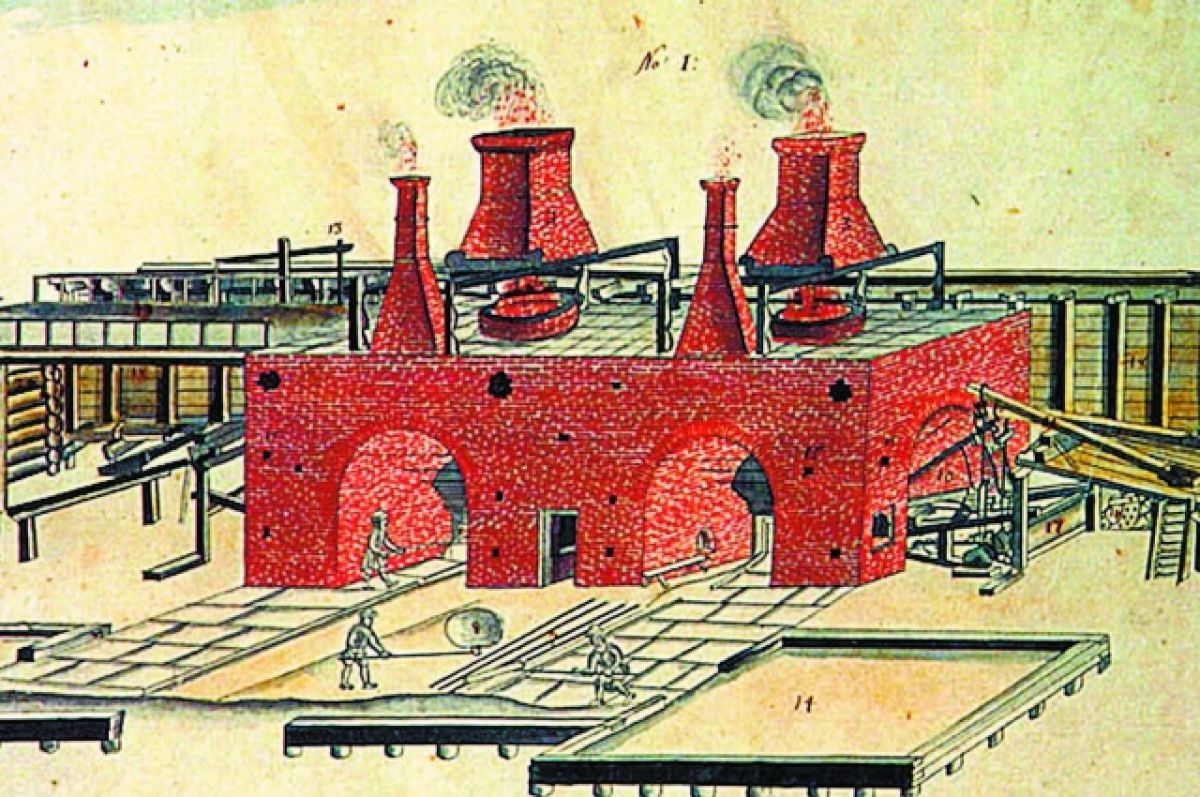A history of cast and pig iron production in the Russian context. Export of pig iron and cast iron. If you need actual pig iron or cast iron from Russia, then go to the Dealing Monster and post your requirements there.

Someone called pig iron “bread of the industry”. Obviously, pre-steel manufacturing of pretty-much anything depended on iron. Before Peter I Russia was an importer of pig iron. But thanks to the reforms of Peter I, Russia came out on top in the world in its smelting. For a while, in the early 18th century, it became the world’s top producer.
Developments During the 18th Century. Holding on.
In the 18th century, the success of iron production in Russia is expressed in the following numbers: in 1718 6.641.000 poods had been made. A pood equals 16 kilograms. Roughly. It equals 40 old Russian pounds or 36.11 English pounds (16.38 kilograms). It is an old measurement unit in use from the 1400s or earlier until the Bolshevik forced the conversion to the modern metric system in the 1920s. So, if in in 1718 6.641.000 poods were manufactured, in 1767 it 9,622,000 poods, in 1800 – 10,300,000 poods.

Import from abroad of iron, which was previously delivered mainly through Archangel, also spelled from Arkhangelsk from Sweden (lead iron), by 1724 had already displaced by local production. Mind you the import of iron from Sweden was out of the question at the time of the Great Northern War with Sweden. Thatäs why they have to rev up the local production. And Peter succeeded at that.
An Export Success… for A While
Later there were even attempts to export iron to England: in 1749, 597,000 poods were exported to England. By the end of the 18th century, exports reached 2,581,000 poods. An incredibly high figure that represented more than a quarter of Russia’s annual production.
In the 18th-century Russian iron was one of the few successful export articles. The export of our iron reached 3.840 thousand poods in 1782. And its value exceeded 5 milliob rubles. The main consumer of our iron was the United Kingdom, which had received from Russia about 2 million poods of iron annually. However, from the beginning of the 19th century, with the dawn of the industrial revolution, the export of iron in general and especially the export of iron to Great Britain has been reduced to negligible proportions.

By the beginning of the 19th century, Russia occupied the 2nd place in the world in the production of pig iron. The second one after England. However, then, for half a century, complete stagnation paralyzed the domestic industry. Russia became a latecomer to the industrial revolution and its agricultural economy did not need too much iron.
Here are the figures.
Pig iron and cast iron production in 1820-1860, thousand poods
| 1820 | 1830 | 1840 | 1850 | 1860 | |
| England | 25211 | 42230 | 86920 | 140056 | 237168 |
| France | 7442 | 13725 | 24583 | 24766 | 54778 |
| United States | 1240 | 10187 | 17690 | 34099 | 50094 |
| Russia | 9333 | 11169 | 11331 | 13892 | 20467 |
If we consider that in 1800 in Russia 10.3 million poods of pig iron were smelted (Ibid. P. 15) , it can be assumed that during 1800-1850 years – or for half a century – the production of pig iron practically did not increase. Despite the fact that England and France or the United States did not stand still. Russia’s performance is however abysmal compared to this trio plus, later, Germany, and it looks favorable compared to the rest of the world.
Second Half of the 19th century
Pig and cast iron production by the leading producers, 1860-1910, thousand poods
| 1860 | 1870 | 1880 | 1890 | 1900 | 1910 | |
| England | 237168 | 369595 | 480196 | 549630 | 633318 | |
| Germany (German Empire) | 31177 | 84858 | 166471 | 284165 | 460910 | 867847 |
| France | 54778 | 71858 | 105225 | 119682 | 165710 | 244061 |
| United States | 50094 | 101576 | 233943 | 561365 | 855310 | 1691835 |
| Belgium | 19516 | 34479 | 37093 | 48058 | 70890 | 110044 |
| Austrian Empire, Austria-Hungary, Bohemia | 19032 | 22790 | 28319 | 58888 | 80090 | 118860 |
| Russia | 20467 | 21946 | 27375 | 56560 | 176828 | 185587 |
The reforms of 1861 caused a catastrophic reduction in the production of pig iron at the Ural factories. In 1862, pig iron production fell to 15,268 thousand poods ( The level of 1860 was surpassed only in 1870. Here are ten more wasted years.
Our country in the first quarter of the past century has become the second in the production of pig iron; then in the forties, it becomes the fourth. The sixties find Russia in seventh place. In 1891 Russia ranks fifth, surpassing Austria-Hungary and Belgium in terms of its production. In the period 1899-1902, we see Russia already in fourth place ahead of France. Following this, Russia again yields to its political ally fourth place, and itself firmly occupies the fifth. Nonetheless, the production increases in smelting and manufacturing of iron, cast iron, and pig iron, in Russia from 1880 to 1890, and from 1890 to 1900 appear very impressive.
Up to the First World War
In subsequent years, Russian industry, not just the production of iron, developed quite rapidly, especially in the last decade of the 19th century. However, the rate of its growth was insufficient to catch up with the world’s most developed countries. So, from 1870 to 1910, the smelting of pig iron in the Russian Empire increased by a factor of 9. Compared with France and England, which increased their iron foundry production by 3.4 times and 1.7 times, respectively, this growth looks quite decent. Alas, iron smelting in Germany increased 10.2 times over the same time, and in the USA – 16.7 times. And if we also count it per capita, the picture will turn out to be quite bleak.

Per Capita Consumption
Thus, the consumption of pig iron in the United Statess exactly 10 times higher than ours, which was 28 kg in 1912. The consumption of small but highly industrialized Belgium, which in 1912 reached 190 kg per head of the population, is 7 times more than ours, the consumption of Germany (156 kg in 1912) is 5 1/2 times, France and the United Kingdom by 4.2 times.
Just as a side note, in 1978 the consumption of pig iron in the former Soviet Union reached 426 kg, and if we recalculate this only to the Russian Federation, then the per capita consumption of cast and pig iron stood at around 600 kg. This is the absolute unrivaled world record which, in all likelyhood, no one will surpass. Even currently, after the so-called reforms and massive restructuring and loss of industrial capacity, Russia is the world’s third-largest producer of iron – the third one after China and Japan. And it went far ahead of its 19th-century competitors.
This is how the share of Russia in the world pig iron smelting changed:
1861 – 3.9%
1870 – 3.0%
1880 – 2.5%
1890 – 3.4%
1900 – 7.1%
1909 – 4.7%
By 1930, under Stalin, it reached 16.7% of the world’s total. And that’s an impressive achievement if one considers that in the aftermath of the First World War, in the year 1920, the same production fell to nothing and represented statistical 0.

